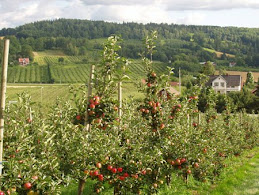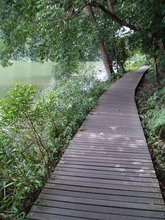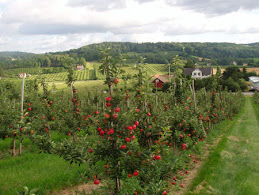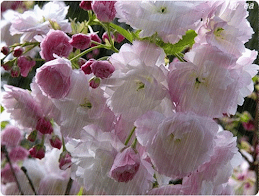From http://epaper.mypaper.sg/emnd/fvxen/fvxp/fvxpress.php?param=2014-04-30
Source Website: http://mypaper.sg/top-stories/if-you-chance-upon-bee-swarm-20140430
By Jalelah Abu Baker and Lee Wan Sim, myp@sph.com.sg, mypaper, Published on Apr 30, 2014
From Wikipedia, the free encyclopedia
https://blogger.googleusercontent.com/img/b/R29vZ2xl/AVvXsEj7TlvkWMl1ewbM6NYZKod4SR-BjttSXO4DGB6xETArph9jlA1ETLY9q6XbJJcEZOS94-XaNPG6SmCKGSfLLKl1MkxompMR51ZboH9fx5Chj-hp1Mgp4D-olaeu7ZbsD9sGmLnbHYqHefE/s1600/Bee_Swarm.JPG
http://upload.wikimedia.org/wikipedia/commons/9/95/Bee_Swarm.JPG
http://en.wikipedia.org/wiki/File:Bee_Swarm.JPG
http://en.wikipedia.org/wiki/Swarming_%28honey_bee%29
IT IS bee season now, and bee sightings seem to be creating a buzz almost every day.
Most pass without incident as bees do not attack people unless provoked, experts told My Paper.
But some cases can turn tragic - like that of Mohammad Sallehen Mohd Ali, managing director of a pest control company. He died in November, after being stung more than 100 times while preparing to attend to a beehive on a fallen tree in Sherwood Road. A coroner's inquiry on Monday ruled his death accidental.
Several factors contributed to the tragedy. He and his two colleagues had only one protective suit among them, and the attack came as they were opening the back of the van to equip themselves.
Pest control companies here said that caution should be exercised when tackling beehives.
Carl Baptista, director of Origin Exterminators, said that beyond getting a description of what is happening, staff should park their vehicle a safe distance from the bees if they are swarming.
Picture posted by Sandra on Wednesday, 19 May 2010 at 09:13
https://blogger.googleusercontent.com/img/b/R29vZ2xl/AVvXsEiDOk3T_1b-Ld1y9MYTEnbqIT7jjhl3U0WzHrvhy_gnm8etc0dSl_YiZy-PrDrGQ5Mrvp2qdl6cWRAQVpAPqJPHZUUc3nQAJ5nXuRjlTsGCUDrQoDLFs2Ij5IkNiQaUJvXEncrNeBbl888/s1600/IMG_0486.JPG
https://blogger.googleusercontent.com/img/b/R29vZ2xl/AVvXsEidCJaDQnLIC82AJJ3PD1GsNK2E-U1RYcUx6Tsb0xPpGbqQGHhdNCEuhdsJJN6IQ0oM3p7Kxq6aIolSmBRwNHE6gmY8_Ak8MMpTqjcEpsst2N3Oyr30fG26EW-A7qb8_eHKq5S8RcwbMmE/s400/IMG_0486.JPG
http://annie-ayearinthelifeof.blogspot.sg/2010_05_01_archive.html
Then, they should approach the hive in a head-to-toe bee suit, which would protect them from bee stings should there be a disturbed hive. If the hive has not been disturbed, a bee suit may not be necessary.
In Mr Sallehen's case, they had parked very close to the hive and were unprotected when the attack came.
The court heard that the bees which stung him were giant honey bees; these are one of the more aggressive species among the five main types found here.
But they are less common than the smaller and less dangerous Asian Honey Bee and Black Dwarf Honey Bee, said John Ascher of the National University of Singapore, who specialises in bee research.
Posted on GeoChemBio.com/biology/organisms/Apis mellifera (honey bee)
https://blogger.googleusercontent.com/img/b/R29vZ2xl/AVvXsEgHvAVU1fhSOzvn-Y4HKXDS-n60ku_bXa_0-f69-ZX0E3M3wIKfQTz_W-Cw_FbS_5fJBBSz61PjgLbcGG-OToynXjViHo0VlIYPgODbXo_tMeWogDNU7Q1R7uf_-2LTkHhPDDuajwZoc8E/s1600/honeybee-with-pollen.jpg
http://www.geochembio.com/IMG/honeybee-with-pollen.jpg
http://www.geochembio.com/biology/organisms/honeybee/#image
This species is also usually found high on trees, reducing the chance of accidental contact with people, Assistant Professor Ascher added.
Bees normally attack only when they perceive that their hive has been or is about to be threatened. "For example, if it has been attacked by a predator or if the tree containing the nest has fallen," he said.
PestBusters chairman Thomas Fernandez, who has been in the industry for more than 20 years, said: "It is important to get as much information from the caller on where the bees are and what kind of activity he sees."
https://blogger.googleusercontent.com/img/b/R29vZ2xl/AVvXsEgXbcguJNr2e7bCBWmz-aVrbHNSQ2VXqC1TtdgaaXD9ZxDW9lLAZcWFfUcMQhPTjDqezEVWxVaOW51o-Zl9hZZCaTJ2epXuwjf-tBjEgOlmJW-EzFyunOupRdxcUQbc7hdR8z9wQvidER4/s1600/2-1-bite-1.jpg
http://www.technologijos.lt/upload/image/n/mokslas/zmogus_ir_medicina/S-37260/2-1-bite.jpg
http://www.technologijos.lt/n/mokslas/zmogus_ir_medicina/S-37260/straipsnis/Mokslininku-atradimas-apmokytos-bites-aptinka-vezi-labai-ankstyvoje-stadijoje?l=2&p=1
Companies said they have rigorous in-house training on pests, their identification and their treatment, which goes beyond training by the National Environment Agency.
The four companies which My Paper spoke to also said that they send only experienced staff to handle bee problems.
Experts offered these tips on what to do if you find yourself near agitated bees:
1. Run away as fast as you can.
2. Try not to kill any - not even one - because a dying bee sends a chemical alarm to other bees to defend themselves.
3. Seek refuge indoors, and shut all windows and doors.
4. Do not try to swat them away.
By Jalelah Abu Baker and Lee Wan Sim, myp@sph.com.sg, mypaper, Published on Apr 30, 2014
Posted on GeoChemBio.com/biology/organisms/Apis mellifera (honey bee)
https://blogger.googleusercontent.com/img/b/R29vZ2xl/AVvXsEj8AEEwrsHMLxmP_lKb-5lnf8HG4YIhavOv76t6eA88XVIA1D-XYuC2bZOokhScRwN0XYxtmqcLGe6RUmY9_TTrkdZ93KxvMehcPh05k-Gty60-QH-fNBla5Mc5FvglqpMnuwENTa0r9iI/s1600/honeybee.png
http://www.geochembio.com/IMG/honeybee.png
http://www.geochembio.com/biology/organisms/honeybee/
Reference
- My Paper, Wednesday, April 30, 2014, Page A4, News, Top Stories
- http://epaper.mypaper.sg/emnd/fvxen/fvxp/fvxpress.php?param=2014-04-30
- http://mypaper.sg/top-stories/if-you-chance-upon-bee-swarm-20140430
- https://blogger.googleusercontent.com/img/b/R29vZ2xl/AVvXsEj7TlvkWMl1ewbM6NYZKod4SR-BjttSXO4DGB6xETArph9jlA1ETLY9q6XbJJcEZOS94-XaNPG6SmCKGSfLLKl1MkxompMR51ZboH9fx5Chj-hp1Mgp4D-olaeu7ZbsD9sGmLnbHYqHefE/s1600/Bee_Swarm.JPG
- http://upload.wikimedia.org/wikipedia/commons/9/95/Bee_Swarm.JPG
- http://en.wikipedia.org/wiki/File:Bee_Swarm.JPG
- http://en.wikipedia.org/wiki/Swarming_%28honey_bee%29
- https://blogger.googleusercontent.com/img/b/R29vZ2xl/AVvXsEiDOk3T_1b-Ld1y9MYTEnbqIT7jjhl3U0WzHrvhy_gnm8etc0dSl_YiZy-PrDrGQ5Mrvp2qdl6cWRAQVpAPqJPHZUUc3nQAJ5nXuRjlTsGCUDrQoDLFs2Ij5IkNiQaUJvXEncrNeBbl888/s1600/IMG_0486.JPG
- https://blogger.googleusercontent.com/img/b/R29vZ2xl/AVvXsEidCJaDQnLIC82AJJ3PD1GsNK2E-U1RYcUx6Tsb0xPpGbqQGHhdNCEuhdsJJN6IQ0oM3p7Kxq6aIolSmBRwNHE6gmY8_Ak8MMpTqjcEpsst2N3Oyr30fG26EW-A7qb8_eHKq5S8RcwbMmE/s400/IMG_0486.JPG
- http://annie-ayearinthelifeof.blogspot.sg/2010_05_01_archive.html
- https://blogger.googleusercontent.com/img/b/R29vZ2xl/AVvXsEgHvAVU1fhSOzvn-Y4HKXDS-n60ku_bXa_0-f69-ZX0E3M3wIKfQTz_W-Cw_FbS_5fJBBSz61PjgLbcGG-OToynXjViHo0VlIYPgODbXo_tMeWogDNU7Q1R7uf_-2LTkHhPDDuajwZoc8E/s1600/honeybee-with-pollen.jpg
- http://www.geochembio.com/IMG/honeybee-with-pollen.jpg
- http://www.geochembio.com/biology/organisms/honeybee/#image
- https://blogger.googleusercontent.com/img/b/R29vZ2xl/AVvXsEgXbcguJNr2e7bCBWmz-aVrbHNSQ2VXqC1TtdgaaXD9ZxDW9lLAZcWFfUcMQhPTjDqezEVWxVaOW51o-Zl9hZZCaTJ2epXuwjf-tBjEgOlmJW-EzFyunOupRdxcUQbc7hdR8z9wQvidER4/s1600/2-1-bite-1.jpg
- http://www.technologijos.lt/upload/image/n/mokslas/zmogus_ir_medicina/S-37260/2-1-bite.jpg
- http://www.technologijos.lt/n/mokslas/zmogus_ir_medicina/S-37260/straipsnis/Mokslininku-atradimas-apmokytos-bites-aptinka-vezi-labai-ankstyvoje-stadijoje?l=2&p=1
- https://blogger.googleusercontent.com/img/b/R29vZ2xl/AVvXsEj8AEEwrsHMLxmP_lKb-5lnf8HG4YIhavOv76t6eA88XVIA1D-XYuC2bZOokhScRwN0XYxtmqcLGe6RUmY9_TTrkdZ93KxvMehcPh05k-Gty60-QH-fNBla5Mc5FvglqpMnuwENTa0r9iI/s1600/honeybee.png
- http://www.geochembio.com/IMG/honeybee.png
- http://www.geochembio.com/biology/organisms/honeybee/














































.jpg)
.gif)
.jpg)





















































%20-%20%E5%82%B7%E5%BF%83%E7%9A%84%E8%B7%AF%20(Sh%C4%81ng%20x%C4%ABn%20de%20l%C3%B9)%20-%20The%20Road%20of%20Sorrow%20(With%20Subtitle)_11.png)


